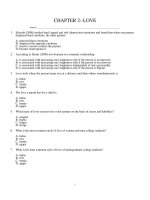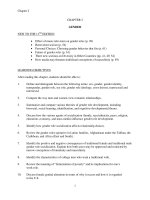Introduction to Race and Ethnicity
Bạn đang xem bản rút gọn của tài liệu. Xem và tải ngay bản đầy đủ của tài liệu tại đây (275.92 KB, 2 trang )
Introduction to Race and Ethnicity
Introduction to Race and
Ethnicity
Bởi:
OpenStaxCollege
Race and ethnicity are part of the human experience. How do racial and ethnic diversity play in
a role in who we are? (Photo courtesy of Agecom Bahia/flickr)
In a mixed vocational/academic high school, Ms. Ellis grades papers for her large,
diverse, 11th grade English class. She is currently looking at the papers of three students:
Jose, who is Dominican, Kim, who is Vietnamese, and Anthony, who is Italian
American.
Jose’s grasp of English is weak, and he doesn’t show a high degree of understanding
of the themes of Hamlet. However, Ms. Ellis knows that Jose tried hard, and she also
believes that, like many of his fellow Hispanic students, he will probably not go to
college and continue any studies of English literature. His parents do not speak English
and are not overly involved in his schooling. Jose excels in Automotive Shop, which
prepares him for a job in that industry, so Ms. Ellis feels that to push him in English will
not help him. She gives him a C+ and a few neutral words of encouragement without
spending a lot of time pointing out where he could improve.
Ms. Ellis wishes she could have more students like Kim. Kim is unfailingly polite,
interested, and hardworking, even though her English still needs work. Her paper on
Hamlet is far from perfect, but Ms. Ellis knows that she probably worked harder on it
than anyone in the class. As is the case with most of Ms. Ellis’s Asian students, both of
1/2
Introduction to Race and Ethnicity
Kim’s parents are anxious for Kim to go to college, so even though Kim’s paper does
not show much more understanding of Hamlet than Jose’s, Ms. Ellis gives her a B and
writes ample comments for areas of improvement.
Anthony is a thorn in Ms. Ellis’s side. In this school where most of the teachers and
vocational instructors are Irish American or Italian American, Anthony has always felt
at home and overconfident. His uncle is on the staff, and he has several siblings and
cousins who have gone through the school. He is aggressive and disruptive in class,
distracting other students and causing Ms. Ellis to spend an inordinate amount of time
on maintaining discipline. Anthony’s paper is about the same level as Jose’s and Kim’s,
but since English is his first language, he really should be able to perform better. Ms.
Ellis gives him a C- and a few curt comments.
Ms. Ellis graded three similar papers very differently. She didn’t grade them only on
their merits; she relied heavily on her own knowledge of and feelings about the students
themselves. Ms. Ellis was guided by her prejudices: her preconceived notions of the
students’ work, attitudes, and abilities. To the extent that her prejudices affected her
actions, Ms. Ellis also practiced discrimination. But what do these terms mean? Does
everyone have prejudices? Is everyone guilty of discrimination? How does our society
foster institutional prejudice and discrimination?
2/2









